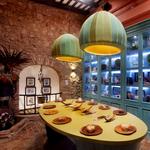Jennifer & Aquias
Things To Do

Colonial Zone
Santo Domingo’s most historic neighborhood is also its most romantic, lively, and cultural. Once the home of Spanish colonialists, who built the walled city as a model for the rest of the Americas, it’s an area brimming with museums, churches, shopping, theater, restaurants, and parks. Along the way, visit the oldest sites in the Americas, including the first cathedral, the first paved street, the first monastery, the first hospital, the first university, and the first military fortress.

Cathedral of Santo Domingo
Built between 1510 and 1540, the first cathedral of the Americas—known as Santa Iglesia Catedral Basílica Nuestra Señora de la Encarcación o Anunciación, Primada de América—continues to stand tall in all of its glory over the heart of the Colonial City. The 500-year-old Gothic-style building continues to serve as the most important site for official ceremonies, and religious celebrations. Touring the interior reveals the cathedral’s ornate Gothic ceiling, colonial period oil paintings, sacred chapel rooms, as well as an area with gravestones containing the remains of archbishops. The remains of Christopher Columbus were found here in the 19th century.

Alcázar de Colón
One of the most popular museums in the Colonial City is also its most impressive in architecture. Completed around 1512, this Gothic and Renaissance style palace was once the home of Diego Columbus, son of Christopher Columbus, and his wife María de Toledo, niece of King Ferdinand of Spain. With views overlooking Plaza de España on one side, and the Ozama River on the other, it is the oldest vice regal residence in the Americas, and the first fortified palace, turned into a museum showcasing 16th century furniture, art, musical instruments, and weapons. Winding staircases lead towards the couple’s well-preserved bedrooms, and to the lavish crystal chandelier-lit reception hall where events were hosted for the Spanish aristocracy.

Kahkow Experience
Operated by one of the country’s top cacao exporters, this part museum, part chocolate factory—located in the heart of historic Calle Las Damas—offers a comprehensive glimpse of the DR’s thriving cacao industry. The multimedia presentation includes a holographic theater, as well as a guided audio walk through the various rooms and visual exhibits, explaining the process of chocolate from tree to pod, and tablet.




